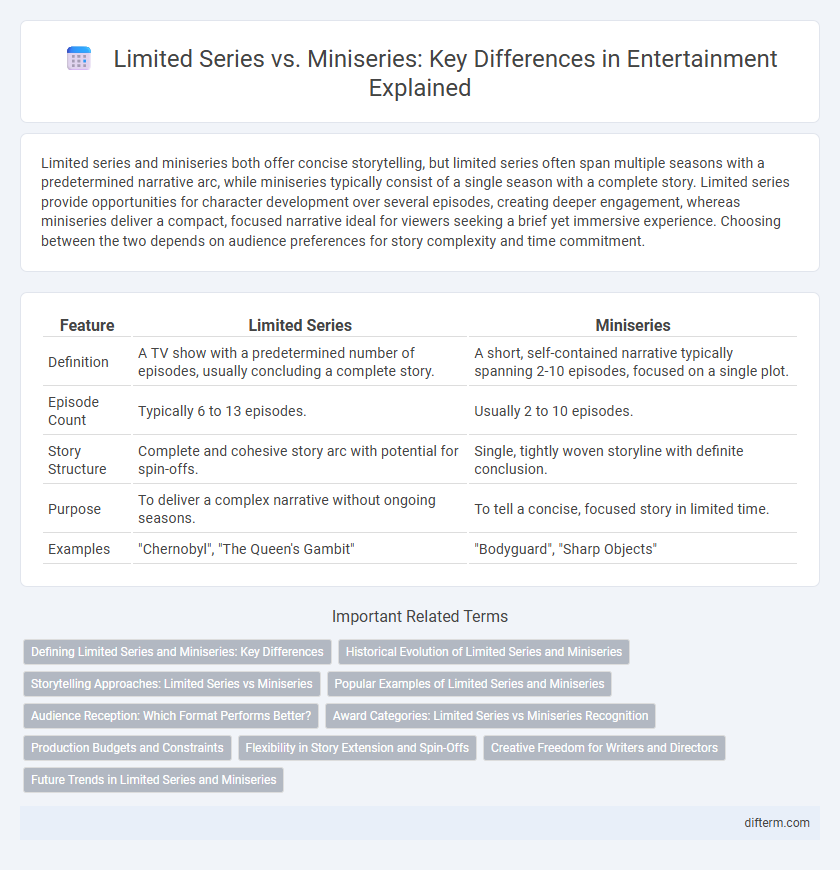Limited series and miniseries both offer concise storytelling, but limited series often span multiple seasons with a predetermined narrative arc, while miniseries typically consist of a single season with a complete story. Limited series provide opportunities for character development over several episodes, creating deeper engagement, whereas miniseries deliver a compact, focused narrative ideal for viewers seeking a brief yet immersive experience. Choosing between the two depends on audience preferences for story complexity and time commitment.
Table of Comparison
| Feature | Limited Series | Miniseries |
|---|---|---|
| Definition | A TV show with a predetermined number of episodes, usually concluding a complete story. | A short, self-contained narrative typically spanning 2-10 episodes, focused on a single plot. |
| Episode Count | Typically 6 to 13 episodes. | Usually 2 to 10 episodes. |
| Story Structure | Complete and cohesive story arc with potential for spin-offs. | Single, tightly woven storyline with definite conclusion. |
| Purpose | To deliver a complex narrative without ongoing seasons. | To tell a concise, focused story in limited time. |
| Examples | "Chernobyl", "The Queen's Gambit" | "Bodyguard", "Sharp Objects" |
Defining Limited Series and Miniseries: Key Differences
Limited series typically consist of a predetermined number of episodes that tell a complete narrative arc with a single season, while miniseries often refer to shorter formats with fewer episodes focused on delivering a concise story. Limited series may have potential for renewal or additional seasons, whereas miniseries are designed as one-off productions with no continuation. The distinction centers on format length, narrative scope, and future production intent within the entertainment industry.
Historical Evolution of Limited Series and Miniseries
Limited series and miniseries originated in the 1970s as television networks sought to create concise, self-contained narratives that differed from ongoing serial dramas. Early successes like "Roots" (1977) and "The Thorn Birds" (1983) established the miniseries format as a compelling method for adapting historical and literary works, while the limited series evolved to emphasize high production values and star-studded casts. Over the decades, streaming platforms and cable networks expanded the format's popularity, blending cinematic storytelling with episodic structure, reshaping audience expectations for both types of series.
Storytelling Approaches: Limited Series vs Miniseries
Limited series offer extended storytelling opportunities with multiple episodes, allowing for deeper character development and complex narrative arcs, unlike miniseries which typically condense the story into a shorter format with a fixed number of episodes. This structure in limited series supports layered plots and gradual tension building, enhancing audience engagement over time, whereas miniseries often deliver a concise, focused tale with a definitive beginning, middle, and end. The choice between them influences pacing, character exploration, and the overall storytelling depth, shaping viewer experience in distinct ways.
Popular Examples of Limited Series and Miniseries
Popular examples of limited series include "Chernobyl," which captivated audiences with its dramatic retelling of the nuclear disaster, and "The Queen's Gambit," a hit that blends intricate character development with a competitive chess backdrop. Miniseries like "Band of Brothers" and "John Adams" are celebrated for their historical accuracy and compelling storytelling over a few tightly woven episodes. Both formats offer high-quality narratives with a defined story arc, often attracting star-studded casts and critical acclaim.
Audience Reception: Which Format Performs Better?
Limited series often receive higher audience engagement due to their concise storytelling and well-defined arcs, resulting in stronger viewer retention and critical acclaim. Miniseries can attract niche audiences with their tightly focused plots but sometimes struggle to maintain broad appeal beyond initial episodes. Overall, limited series typically outperform miniseries in ratings and social media buzz, reflecting a growing preference for binge-worthy, high-quality content.
Award Categories: Limited Series vs Miniseries Recognition
Award categories distinguish between limited series and miniseries based on episode count and narrative scope, with the Emmys often using "Limited Series" to encompass both formats. Limited series awards recognize productions with a concise but complete story arc, typically spanning multiple episodes with higher budget and star power. Miniseries, historically shorter and more focused, may receive separate accolades in some ceremonies, yet the trend leans toward merging categories to reflect evolving storytelling styles.
Production Budgets and Constraints
Limited series often feature higher production budgets compared to miniseries, enabling more elaborate sets, special effects, and top-tier talent acquisition. Miniseries typically operate under tighter financial constraints, resulting in shorter runtimes and more focused storytelling to maximize investment efficiency. Budgetary differences directly influence narrative scope, with limited series allowing for expansive world-building, whereas miniseries prioritize concise, impactful narratives.
Flexibility in Story Extension and Spin-Offs
Limited series often provide greater flexibility in story extension and spin-offs due to their open-ended narratives and character development, allowing creators to revisit or expand the storyline in future projects. Miniseries typically have a more contained, definitive plot designed to conclude within a set number of episodes, limiting opportunities for continuation or spin-offs. The adaptability of limited series makes them ideal for evolving story arcs and franchise expansions in the entertainment industry.
Creative Freedom for Writers and Directors
Limited series offer writers and directors expanded creative freedom by allowing more episodes to develop complex story arcs and character depth without the constraints of ongoing seasons. Miniseries typically have a shorter span, providing a focused narrative but often restricting the exploration of subplots or extended world-building. This flexibility in limited series enables more intricate storytelling and stronger artistic expression within a controlled episode count.
Future Trends in Limited Series and Miniseries
Future trends in limited series and miniseries highlight a growing investment in high-quality, concise storytelling that caters to streaming platforms' demand for binge-worthy content. Increasingly, creators are blending cinematic techniques with episodic formats, attracting top-tier talent and audience engagement through tightly woven narratives. The rise of international co-productions and diverse genre explorations further expand the global reach and innovative potential of limited series and miniseries in entertainment.
limited series vs miniseries Infographic

 difterm.com
difterm.com